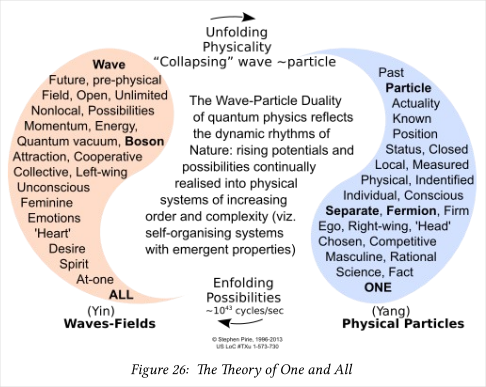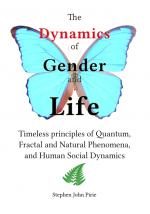[comments and questions can be posted on Stephen's substack page, at Session 2 - two impossible ideas]
TL;DR (Summary)
- A heavy focus on the physical encourages a mechanistic, competitive world view
- The dual nature of physical and meta-physical gives insight into gender stereotypes
- The masculine and feminine archetypes are echoed in the quantum realm
Transcript:
Hello, I’m Stephen Pirie, Author of “The dynamics of gender and life”.
In session one, I mentioned an Ancient Greek philosopher who questioned how things moved around.
His name was Zeno of Elea and even though his questioning perplexed and troubled a great many people, the root assumption of perfectly smooth flowing physical movement remained intact.
That assumption encouraged a mechanistic world-view in which everything and everyone was accepted or believed to be always here in the physical. The world and the universe was seen to be like a great big, albeit immensely complex clockwork mechanism, that was always running, always working away in the background. Our bodies were likewise believed to be complex biological machines, and as a result our medical systems treated our bodies as such. Various body parts that were failing to function properly, just needed some chemical treatment, or replacement, and then the body would be good to go.
That mechanistic world-view has been deeply entrenched in our culture for much of the last 2,400 years. So it’s not like we might expect to wake up tomorrow, as a culture, and think, “okay, out with the old, in with the new”. It’s deeply embedded. An example: there are those who openly state that we’re programmable biological machines – that we’re ‘hackable animals’. There are those who, immediately upon their death, have their bodies placed in long-term cryogenic storage in the belief that one day clever scientists will be be able to thaw them out, kick start their body, and fix up whatever body parts were originally faulty or diseased etc. Pretty much everything about life is seen in that mechanical-world context.
Most of all, that mechanical world-view has encouraged a competitive approach of physical parts needing to fight or control other physical parts.
That mechanical world-view meant we’re alone, as separate, distinct individuals, bereft of a supportive, underlying quantum inter-connectedness that has now been confirmed experimentally. In other words, the experimental fact of there being a deeper quantum interconnectedness means it's independent of whichever theory, opinion or belief one has about physical reality.
Lacking a sense of an underlying, supportive ‘oneness’ has led to what might best be described as our cold, mechanical treatment of the natural world.
So we have pesticides and antibiotics to kill those parts that are deemed unhelpful to the functioning of whichever biological system we’re focused on.
Parts fighting, controlling or killing other parts is seen as the natural order of our world.
With the inertia of that 2,400 years of Western cultural belief, when I introduced the idea that we’re very rapidly and repeatedly cycling in and out of a deeper meta-physicality, that’s not going to be an immediately obvious thing to accept.
In my book I wrote a section titled “Impossible”, in which I say [quote]
It is, at first glance, an impossible idea – that the universe, and all the stuff within it including our bodies is physically disappearing and reappearing many trillions of times each second. As you read these words, or listen to them, you might look around you, at the computer, tablet or book with which you’re reading this material, the desk at which you sit, the various electronic devices nearby, such as a printer, a mobile phone, and think “no way, impossible.” [unquote].
And yet, it’s harder to believe we push through a never-ending series of little movements when we do anything, such as breathing, thinking, moving, etc.
So basically we are faced with two seemingly impossible ideas.
What are we to do?
My approach is to use the idea that we’re rapidly and repeatedly cycling into a deeper meta-physicality, as a guide to life. It’s a model that is of practical benefit.
For example, when faced with difficulty, I remind myself that there’s hidden opportunities and solutions that are resident in the meta-physical, and that I have simply to see them. In other words, the model compels me to ignore what I know, and to focus on what I am seeking to learn and achieve. This has been of immense importance and practical benefit to me when writing about the deeper rhythms and processes of life. I’ve intuited much of what I have come to learn by expecting to be surprised with new insights. Sometimes I’ve experienced an avalanche of ‘Eureka moments’ again, because I was mindful of the potential to receive intuitive new insights.
In my experience, the model of our cycling in and out of a ubiquitous meta-physicality is immensely reassuring. It means there’s more to life than current circumstances indicate.
And, it’s a model that provides an expansive context to understand our reality.
For example, it provides a meaningful context to understand gender stereotypes. The meta-physical ground, or source from which all of physicality is continually unfolding, gives rise to the feminine archetype. The meta-physical source is the repository, the womb if you like, that holds all potential and possibilities. It’s mysterious, in that it is, and remains beyond what is known, and can be known and seen – hence ‘feminine mystique’, never ‘masculine mystique’. We are all of the same source, hence the feminine embrace of sameness – of late we see that in our culture as a trend toward sameness of outcomes, called equity.
In the meta-physical realm which is of the same source for all, we’re intimately, instantly interconnected in ‘oneness’. Hence the feminine bias toward relationships and the subjective sense of empathy, intuition etc.
Meanwhile in physicality, all parts are uniquely different to one another, which gives rise to the masculine archetype of being separate, alone individuals with identities, objective, measurable qualities of height, weight, and so forth.
Basically, there’s a duality to life, which is of being different individuals while being of the same source.
That dual nature of same while being different is echoed in the chromosomes – males have different XY chromosomes, females have the same XX chromosomes.
Anyway, in Session 1 I alluded to root principles. That’s one of them – that we’re irrevocably, irreducibly the same while being different. It’s a paradox that will remain as such. To get an everyday sense of what the same while being different means, consider an individual within some community. The individual is not the community nor is he/she not not the community. The conundrum is resolved by defining any individual as being the community-as-the-individual.
Another approach is to consider where is the divide between one’s hand and one’s body? The answer is there is no answer to that. The hand is, simply, the body-as-the-hand.
Now the same-different dichotomy is evident at the quantum scale, at which there are, shall we say, masculine particles that remain resolutely different to all others, and they will not share their space.
There are what we might call feminine particles that blend, bind and bunch together in seeming ‘oneness’ so to speak. A laser beam is an example of how feminine particles synchronize their periods, or waveforms into one coherent beam that behaves as if it’s just one super-intense particle.
Much of this is explained in greater detail in my book “The Dynamics of Gender and Life: Timeless Principles of Quantum, Fractal and Natural Phenomena, and Human Social Dynamics”.
This podcast is posted on my website stephenpirie.com, as well as on my substack at stephenpirie.substack.com – that’s stephen with a ph, and pirie, spelt p-i-r-i-e.
Insofar as my name is often misspelt, I’ll include links to my work on a simply-named site that should be easier to find and remember and that is beliefclinic.com.
Comments about, or questions relating to my podcasts can be left on my substack pages.

